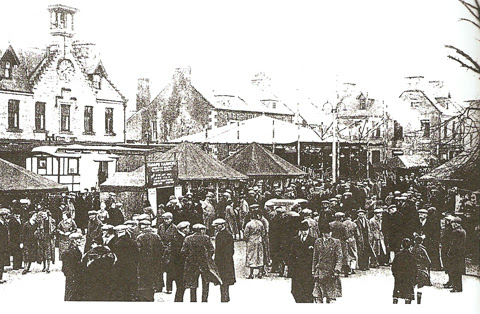O
Earlston Hiring Fairs,
held in the Market Square, were important events where men and women
farm workers, (ag.labs (agricultural labourers), hinds*, ploughmen,
shepherds, dairy maids. domestic servants etc.) would gather to bargain
with prospective farmers for work, and hopefully secure a position for
the following 6-12 months.
*The Scottish National Dictionary defines a "hind" in Southern Scotland and Northumberland as "a married skilled farm worker who occupies a cottage on the
farm and is granted certain perquisites in addition to wages.
Special trains were laid on by L.N.E.R. offering cheap days excursions to Earlston for the event.
Southern Reporter: 20th February 1936
Hiring
Fairs were also social occasions with a rare opportunity for friends
and family to meet and enjoy side shows and stalls, with often all-day dancing
in the Corn Exchange, and a chance to take teas in the Masonic Hall or a
dram in one of the public houses.
Earlston Hiring Fair 1934
Issue of Wage Rates
But
in the 1930's, the depressed state of agricultural wages was a live
issue. A rise after the First World War had seen a fall during the
1920's and a further decrease in the early 1930's. "The Scotsman" of 24th February 1931 reported on Earlston Hiring Fair, noting that:
"As
this is one of the first Border hirings in the year, considerable
interest was evinced in agricultural circles regarding the question of
wages. There was a large attendance, but hiring was very small, owing
presumably to the reluctance of farm servants to accept a reduction in
wages. These showed a decrease of 2s-3s per week compared with last
year. Ploughmen are likely to receive 30s.-33s. per week, with harvest
allowance and the usual emoluments; women workers from 18s-21s; boys
according to ability 15s to 20s."
[The 2 shilling per week decrease represented £4.68 in today's money; 30 shillings per week - £68, and 18 shillings - £24.]
Source: National Archives Currency Converter
How Much Did Food Cost?
The
Office of National Statistics reported that prices for everyday items
such as bread, sugar, tea, cheese, margarine, eggs, potatoes and flour all
increased in price after the First World War, peaking around 1920. They
then fell slightly, but remained above the 1918 level through the 1920s
and 1930s.
The local press reported that in 1935 the price of bread increased from 71/2d to 8d per 4lb loaf. The two Galashiels advertisements below from "The Southern Reporter": 10th December 1936, give an indication of prices at the time, though no doubt they were promoting many items well above an agricultural worker's pocket.
An advertisement for James Galbraith, Galashiels
Thomas Rae on Bank Street was advertising gifts
A series of meetings of farm workers were held across the Borders including St. Boswells to discuss the issue of pay. Then in 1937 an
Agricultural Board was established, representing the interests of employers and employees to set minimum wages, holiday entitlement, and working
conditions for agricultural workers. A separate body for Scotland was set up in 1949 with representatives from from the National Farms Union of Scotland and the
Scottish Landowners Federation.
Seeking Farm Vacancies
Times were changing, and increasingly
during the 1930s farm vacancies were being advertised in the local press.
Workers were also showing a reluctance to move, especially if they were
already living near a town or on a bus route and their farm cottages were
being improved.
A typical listing of jobs advertised in "The Southern Reporter" of 10th March 1936. Note no pay rates are stated, and many vacancies stipulated along with the man, a wife to look after cows and poultry, and strong boy(s) to assist on farm.
In the same year, an item in "The Berwickshire News" noted:
"There is reason to believe that in the not too distant future, farm hirings will fall into abeyance."
A report on Kelso Hiring Fair in "The Southern Reporter" 10 January 1938 was typical of the concern.
With the onset of war in 1939, hiring fairs died out. but in Earlston, "the Shows" remained a tangible link with the past, and continued to come into the Square well into the 1960's.
***************
Press Cuttings and Press Comments sourced on






